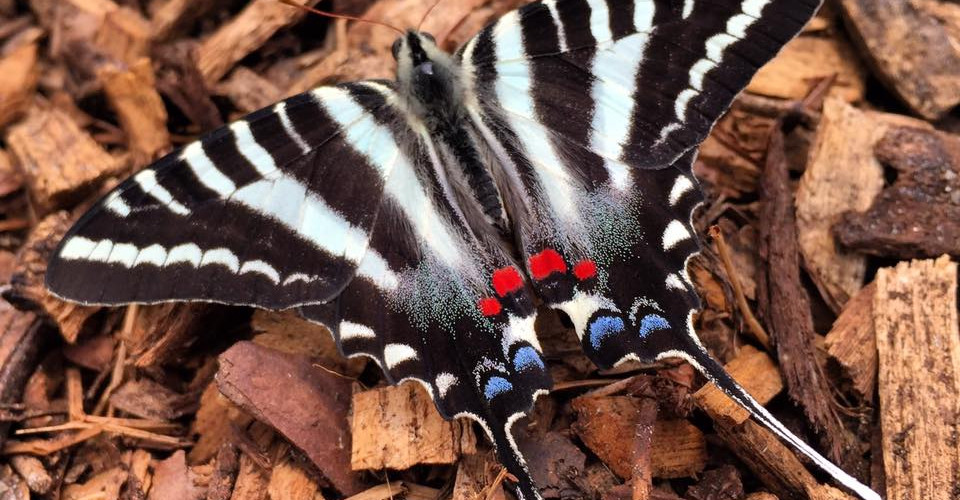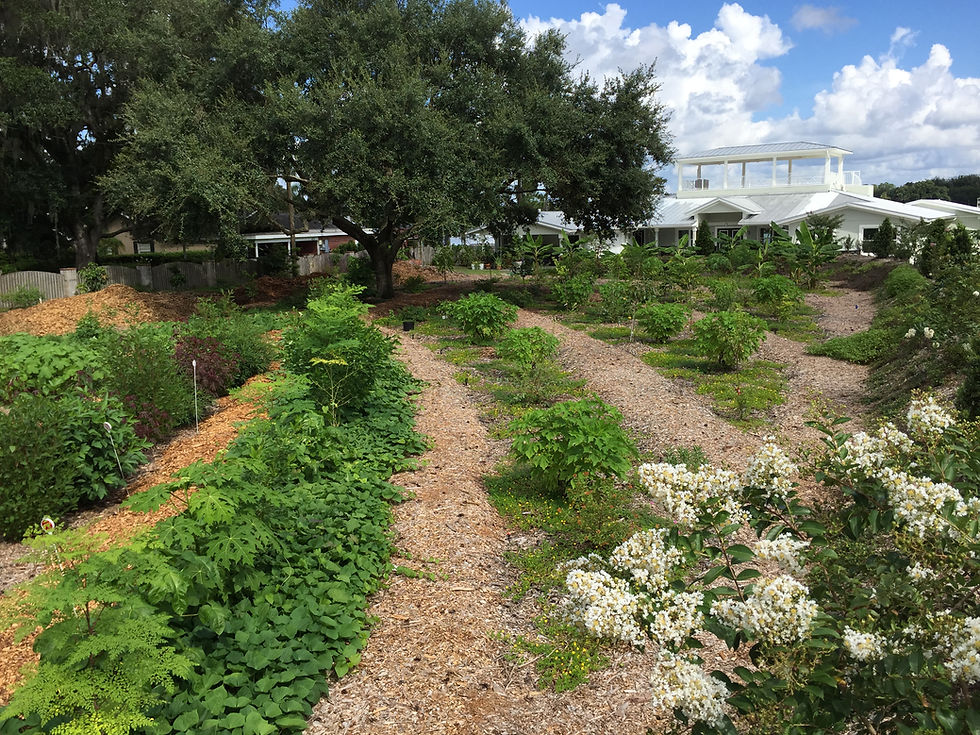Building An Ecosystem From the Ground Up: Healthy Soil
- Melissa Kanaris
- Jul 5, 2016
- 5 min read
CONVERTING YOUR FLORIDA YARD INTO AN
EDIBLE LANDSCAPE OR ECOLOGICAL FOREST GARDEN:
A BEGINNER’S SHORT GUIDE
Step 1: Healthy Soil
Start with an understanding of healthy soil.The single most important detail of successful organic gardening here in Florida is to understand the conditions our soil & what we can do about it. Mulch is everything & we cannot overstate that enough. We are not talking about ordinary garden mulch, though – bagged mulch from the garden store isn’t going to give us what we need. The mulch we are referring to is the biologically diverse, partially decomposed mulch that comes from tree trimmings; it contains billions of organisms in one square inch & builds soils.
Why Is The Soil So Important?
Each one of our garden installations is built from the ground up, in a very literal sense. The soil itself might be the most important work we do. We believe that building the healthiest soil possible that creates the healthiest plants possible. While me might be lucky to have year-round growing seasons here in Florida, the downside is that the ground underfoot is an extremely porous sandy situation. Our rainfall washes straight down to the aquifer within a matter of hours, leaving us dry as a bone by the following day.
When the soil is out of balance, it is an invitation for weeds, pests & disease. Each of these so-called “problems” is really only a correction of an imbalance. Pests & disease are nature’s “clean-up crew” taking out what isn’t healthy & thriving. Weeds come in to replace key nutrients & fill in space to keep ground covered. When you create an ecological garden, you invite balance & create a space that resolves it’s own issues, leaving no opportunity for the usual dilemmas.
Here in our modern times, culture tends to forget how precious our soil is. We brush it off as if it's just "dirt", when in fact it is a rare occurrence in our universe. It is literally what gives our planet it's name - THE EARTH.
It is the foundation of life.
It is life.
Here's some mind blowing research:
There are thousands of different species in just 1 tiny gram of forest soil! That means that the earth you walk on is not just a lifeless mix of minerals & grit, but an entire ecosystem of itself; full of fungi, bacteria, protozoa, nematodes & anthropods. These highly underrated micro creatures are essential to gardening like the forest. The forest doesn't need petrochemicals to grow & it doesn't need tilling either. It has survived & provided to it's inhabitants for millennia, with it's own built in micro team & the organic matter they provide. This organic matter amplifies the water & nutrient holding capacity. You can think of this ecosystem as a biologically active sponge.
How to Build Soil like the Forest: Bringing In The Right Kind of Mulch
We have learned that the #1 key to garden success is to use heavy mulching techniques directly over the top of our area’s current sandy conditions. Our partially decomposed hard wood mulch has been essential in creating thriving gardens & large-scale agriculture... even without the use of irrigation! What makes this mulch so special is that it is still undergoing the decomposition process, which guarantees tons of moisture & life within it [mycelium (beneficial fungi) & beneficial microorganisms.] This mineral & humus-rich material, which is breaking down into compost, is a full ecosystem in itself; it is a biologically active promoter of plant growth – whatever you choose to plant in it.
But be informed; not all mulch will work the same! When you purchase your mulch from the box stores, you generally are only getting bark & wood chips, which are void of life. The mulch we provide from hardwood tree trimmings has been properly handled & aged here at our home base. It also contains twigs, leaves & moss, which all contribute to the composting process, attracting beneficial organisms such as earthworms, good bacteria & fungi. We frequently treat our composting mulch matter with our own bioactive compost tea, to infuse a heavier concentration of vital soil organisms.
What About Compost?
Why Would We Use Mulch instead of “Compost? We see compost as an end result. It is a finished, broken down material. It certainly has tons of nutrients & is a dream for our veggies’ roots, but it’s black gold value is best appreciated when it’s used properly. Eventually, if you were to leave the mulch for a long period of time, it would become compost. When you only use a broken down product, you are lacking all of the life activity that takes place during the breakdown process. This is why we use the biologically active mulch as our foundation, instead.
There are only a few applications, where compost is better suited for the job:
When transplanting seedlings or smaller sized plants into the ground, it is helpful to add composted soil in the areas just surrounding their roots, then after planting – cover any exposed compost with mulch.(Compost should never be exposed, or it will dry out.)
Raised planter beds should be filled with a compost mix, and then topped with biologically active mulch.
Starting seeds directly or in trays.The finer, broken down material is better for this job, since seeds need full contact with their surrounding area to have the best germination & strength.We have had success seeding small mounds of compost directly over our mulched beds. We lightly cover the surrounding area with the live mulch.
BEFORE YOU GO RUSH TO COVER YOUR LAWN WITH MULCH…
We want to emphasize how important it is to have a full plan before you cover an area with mulch. It is very important that you have your plant choices ready when your mulch is spread & that the area has been cleared of grasses or any other tenacious plants that could come back. We will cover more on this topic in future steps, but to give you a little glimpse: Open mulched spaces with nothing planted = an invitation for weeds + dryness. We suggest planning out 1 achievable project area/zone at a time, according to budget/personal time constraints. We also suggest deep mulching - the thicker you can lay it down, the more of a challenge that the weeds & running grasses will have breaking up & through the surface. To check out the rest of the steps, you can get back to the guideline by clicking here.
To learn more about the soil ecosystem & the “Soil Food Web”, you can learn a great deal through Dr. Elaine Ingham. Her website is www.soilfoodweb.com
To learn more about our mulch & to check our pricing, you can learn more through our webpage by clicking here. You can also learn about our compost, compost tea service & biochar availability.
Check Out the next blog post: Getting acquainted with the Fungi & Beneficial Insects…
Save

































コメント